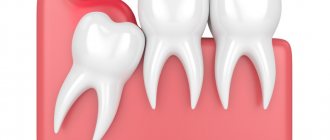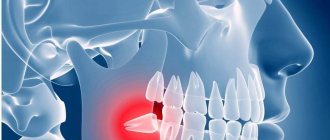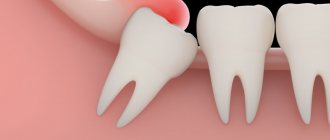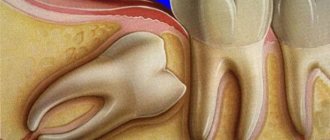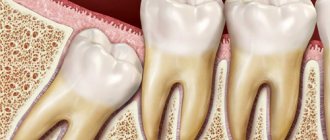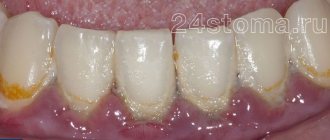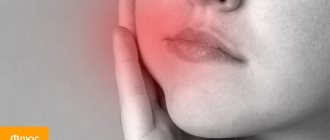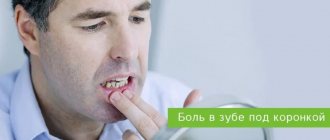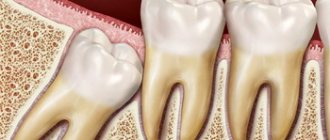Features of wisdom tooth eruption
Wisdom teeth or third molars, also known as figure eights, are the outermost teeth in a row, located at the edges of each jaw. There are four of them in total, but often not all of them erupt, and sometimes they may not grow at all.
This will not affect the chewing functions of the jaw, and if you do not have a single eight, there is no need to sound the alarm.
The eruption of third molars is possible at any age, even after 30 years; the patient’s age does not affect the course of the process. But the direction of growth, the presence of free space in a row, the structural features of the jaw can significantly influence the process - will it be painful or will it go unnoticed, will there be a health hazard and will the growth provoke the development of inflammation.
What to do to eliminate the tumor?
If, after the removal of a wisdom tooth, the tissues nearby are swollen, then the patient’s main task is to follow all the doctor’s instructions after the procedure. This is the only way to minimize swelling and pain.
It is necessary to keep the affected area cold and under no circumstances heat it - this is the main and fundamental condition for the fight against swelling. The cold is kept every hour and a half for 7-10 minutes during the first day after the intervention. A thick cloth soaked in cool water or a bottle of water chilled in the freezer are suitable as a source of cold. In this case, you need to periodically change the compress when it warms up, and make sure that the skin is not frostbitten.
It is advisable to measure the temperature on the first day after surgery; it may increase, but should not exceed 38°C.
Eating hot food and drinking, taking a hot bath or shower, and visiting bathhouses is prohibited for at least two to three days after the event. Also, after removing a wisdom tooth, you should not puff out your cheeks and rinse out the protective blood clot from the wound. It is not recommended to chew on the removal side.
Antibiotics are prescribed as medications (for example, Tsiprolet 500 mg for 5 days, two tablets per day) to reduce the risk of infection. Painkillers are also prescribed (in particular Nimesil powders, no more than three packets per day).
Be sure to brush your teeth, this again reduces the risk of infection. However, you should be careful near the socket of the extracted tooth so as not to damage the protective blood clot. For the procedure, it is better to give preference to a tool with soft bristles.
Whether the cheek is swollen after the removal of a wisdom tooth or not, for the treatment and prevention of swelling, in any case, you can use Dicynone, treat the wound with Miramistin, or do oral baths with chlorhexidine. You can also rinse your mouth with anti-inflammatory substances and solutions: infusion of chamomile or sage, furacillin, etc. But rinsing should be done very carefully so as not to disturb the protective clot.
Special gels will help reduce tissue swelling and pain, and also effectively fight inflammatory processes. The prescription of such medications is carried out only by the attending dentist.
It is also advisable to at least temporarily exclude cigarettes, alcoholic beverages, foods with a lot of salt, sugar, hot spices and solid foods from your life. During the healing period after surgery, it is better to give preference to foods with a soft consistency.
Pathologies that require dental care
Eights can take several days, months, or even years to erupt. Growth is accompanied by a slight aching pain, swelling, and redness of the gums - this is the norm.
But there are a number of symptoms that indicate the development of complications and when you should consult a dentist:
- severe acute pain in the gum area;
- pain that spreads to the ear, throat, temples, head;
- increased body temperature;
- inflammation of gum tissue, purulent discharge;
- the appearance of bad breath;
- discomfort, pain when chewing;
- pain when opening the mouth;
- enlarged lymph nodes.
These are signs of inflammation that can lead to infection, loss of adjacent teeth, and sepsis.
Possible pathologies during the eruption of wisdom teeth:
- Incorrect position of the tooth, as a result, it grows sideways into the cheek, injuring, causing pain and inflammation of the soft tissues. At the same time, it causes displacement of the remaining dental units and malocclusion. In the worst case, a malignant tumor may form. It is impossible to correct the direction of growth; the incorrectly growing molar must be removed.
- If it grows towards an adjacent unit, it will damage or completely destroy its crown. The pathology is accompanied by constant severe pain, the inability to chew food normally, and talk. The solution to the problem is surgical removal.
- Pericoronitis is inflammation of the gums. Since the third molars are located in an area that is difficult to clean, leftover food, drinks, and microbes get into the gum tissue. Bacteria cause infection, inflammation, dangerous intoxication of the body, blood poisoning. Symptoms of pericoronitis include severe swelling of the gums, facial asymmetry, acute persistent pain, purulent discharge, and high fever. You should contact the clinic immediately.
First aid
Before going to the dentist, you can relieve pain at home using certain pharmaceutical products.
- Drink a painkiller drug - Nimid, Nice, Analgin, Ketanov, Paracetamol, Tempalgin.
- Place the turunda on the swollen area with a special ointment or gel - Kamistad, Dentinox, Metrogyl-Denta, Cholisal.
- Rinse the mouth with antiseptic solutions - Miramistin, Chlorhexidine and Furacilin.
You can use home help methods for three days. Next, the supervision of a professional doctor is necessary. If the pain does not go away and the swelling does not go away, then you should immediately visit a dentist to find out and eliminate the cause of the painful condition. Inflammation during pericoronaritis is relieved by washing the gingival hood with pharmaceutical antiseptic solutions: Iodopharm, Potassium permanganate, Furacilin.
How to eliminate pain and discomfort
In the absence of pathologies, it is possible to eliminate pain by taking painkillers Nurofen and Ibuprofen. Ideally, consult your dentist before using anesthetics.
It is impossible to accelerate growth or influence the process, but you can facilitate it by cutting the gum. The decision about surgery is made by the dentist based on the clinical picture.
Minor inflammations can be easily removed by rinsing the mouth with antiseptic compounds and herbal decoctions. Otherwise, all you have to do is wait for the tooth to erupt. A consultation with a specialist will allow you to identify deviations in time and prevent risks.
Why does swelling occur?
Edema is the excess accumulation of blood in the extracellular spaces of the body to speed up healing. If your cheek is swollen after wisdom tooth removal, there may be several physiological reasons:
- manifestation of an allergic reaction to the anesthetic;
- purulent focus of inflammation, usually eliminated before surgery;
- elongated roots of the tooth being removed,
- high pressure.
The listed factors are mainly individual for each organism. Most often, swelling of the cheek after wisdom tooth removal is a natural protective reaction to surgery. If no pathological factors are observed, and the dynamics of healing proceed as expected, then there is no need to worry.
If swelling occurs due to natural causes, this condition is considered normal.
How to determine natural origin?
- The tumor appears a day after the intervention.
- Pain and swelling gradually subside.
- Body temperature is normal or slightly elevated.
- Slight pain during swallowing or chewing processes.
Even if the tumor looks terrible, the first few days after surgery may be completely normal. You should be concerned if, after the allotted time, there is a tendency for pain and swelling to progress.
In what cases should you consult a doctor?
Have you had your wisdom tooth removed, and after a couple of days or more have you noticed swelling that is increasing? What to do? Such symptoms cannot be ignored. Urgently need to visit the dentist! You should contact the clinic as soon as possible in case of high fever, discharge of pus, growing swelling, severe redness of the gums and bleeding, so that the situation does not worsen. The doctor will take the necessary measures. The patient may need to wash the hole, open the abscess, and prescribe medications.
If your cheek is swollen and hurts, or swelling has taken over the area under the eye, you cannot do without medical help. Monitor your health, and if there is a sharp deterioration, call an ambulance. You should contact your dentist if you have difficulty swallowing, chewing food, or opening your mouth. The patient feels a deterioration in health when the blood clot is washed out of the socket. In its absence, inflammation often appears. Therapy consists of applying medications that will quickly relieve discomfort.
The clot may suppurate and alveolitis may develop. Self-prescribing antibiotics is unacceptable. Only a doctor can alleviate the patient’s condition, clean the hole, and place it in medicine. It happens that a hematoma develops. At first, it does not cause painful attacks or swelling. However, as soon as obvious signs appear, a visit to the dentist is mandatory. The doctor will open the hematoma and prescribe therapy.
Why does the gum around the wisdom tooth hurt?
The inflammatory process in the area of the third molar is always accompanied by swelling and pain. This allows you to notice it immediately and begin treatment in a timely manner. Before giving prescriptions to the patient, the dentist finds out the cause of the disorder. This is necessary to eliminate the infectious focus and prevent relapse.
Radiography is used to make the correct diagnosis. In the image, the doctor sees what is happening to the tissues and how far the inflammation has gone.
The main reasons look like this:
- wisdom tooth coming out;
- pericoronitis developed;
- a carious process occurs in the cervix.
Pain due to wisdom tooth cutting
Eights can appear both at 20 and at 50. And each case is a variant of the norm. You can never predict when these units will decide to show up. You can understand that a wisdom tooth is growing by the following signs:
- increase in gum volume;
- compaction and redness of tissues;
- pain when touching the inflamed area.
It happens that a unit does not cut through for a very long time. This is possible when the volume of bone structures is too large, there is insufficient space to accommodate a volumetric crown, or the unit is in a dystopic position (then it grows to the side or at an angle).
Pericoronitis as a cause of pain
The tissue surrounding the third molar may become inflamed. Plaque actively accumulates in the hole through which the figure eight erupts. A so-called gingival hood is formed. It does not allow the unit to “pass” completely and is a suitable place for the growth of bacteria and the accumulation of food debris.
Dental neck caries
The third molar has the same structure as the rest of the oral cavity, so caries on its surface is not uncommon. Then he hurts himself or the gums near him ache.
Due to the peculiarities of the position of the unit, a person usually does not have the opportunity to examine the carious cavity. Therefore, you should visit the dentist's office. Neglected caries leads to pulpitis. Then the treatment will be much more difficult.
Other reasons
Less common causes of discomfort in the figure eight area include:
- burn of mucous membranes;
- mechanical damage to tissues;
- hormonal imbalances, long-term use of hormonal medications, thyroid diseases;
- wearing incorrectly selected or low-quality removable dentures;
- stomatitis;
- gingivitis.
Prevention
To prevent problems associated with wisdom tooth growth, the following measures should be taken:
- Timely visit to the dentist . Even in the absence of complaints, it is necessary to conduct an oral examination at least twice a year to identify possible diseases.
- High-quality teeth cleaning . Teeth should be brushed thoroughly twice a day for at least three minutes. Once every three months it is necessary to replace your toothbrush.
- Delivery of essential vitamins and minerals to the body . You need to eat foods rich in calcium, phosphorus and vitamin C.
Many experts recommend removing a wisdom tooth when it grows incorrectly. In this way, maximum treatment effectiveness is achieved. But patients are not always ready to take such a step, since there is an opinion that “a person cannot have extra organs.”
Indeed, the “eight” may prove useful in the future, when it is necessary to secure a denture if other teeth are lost.
The “third molar” is cut at a later age, which means it begins to deteriorate much later, which allows it to withstand the load of the prosthesis, which the rest of the teeth are no longer capable of.
Often, when the erupting wisdom tooth is potentially in the correct position, the doctor suggests getting rid of not the tooth, but the “hood”, which can lead to inflammation. This procedure is simpler and safer. For the patient under local anesthesia, the excess part of the gum is simply cut off. In the future, you will need to use antiseptic solutions and ointments prescribed by your doctor for some time. But the tooth will now be able to develop unhindered in the oral cavity.
Causes of swelling of the cheek and gums during wisdom tooth growth
A “hood” appears over the erupting “third molar,” just like over any other tooth that begins to grow. It is a fold of gum, which, if the tooth is positioned correctly, should be cut by it, giving way for further growth. But, if there is a shortage of space, the “hood” remains. Residues of food can get there and, in combination with insufficient cleansing of the space closed by the gums with saliva, the growth of harmful bacteria occurs. As a result, an inflammatory process begins - pericoronitis.
This disease can be provoked by reasons related to external factors, or as a result of delaying the cutting process itself. The first case includes:
- Injury to soft tissues around a growing tooth by hard food particles or a toothbrush.
- The appearance of small ulcers or erosions on the gums.
Tightening of cutting occurs in the following cases:
- Lack of free space in the oral cavity.
- Increasing the thickness of the gums at the cutting site.
- An increase in bone tissue density associated with the absence of a preliminary presence of a baby tooth in the places where the “eight” appears.
The later a person’s wisdom tooth grows, the more severe and painful the consequences accompany the process of eruption.
